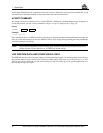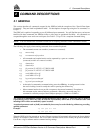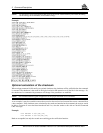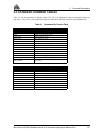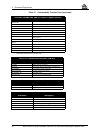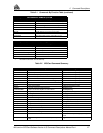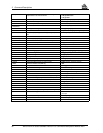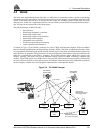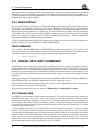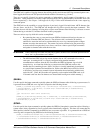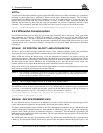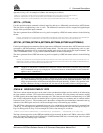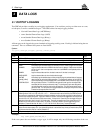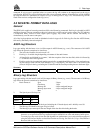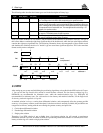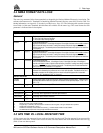
2 Command Descriptions
30 MiLLennium GPSCard Software Version 4.50 Command Descriptions Manual Rev 1
The signal broadcast via the WAAS GEOs to the WAAS users is designed to minimize modifications to standard
GPS receivers. As such, the GPS L1 frequency (1575.42 MHz) is used, together with GPS-type modulation - e.g.
a Coarse/Acquisition (C/A) pseudorandom (PRN) code. In addition, the code phase timing is maintained close to
GPS time to provide a ranging capability.
2.3.1 WAAS GPSCard
NovAtel has developed several models of WAAS-capable MiLLennium GPSCards that process WAAS signals.
These models can output the WAAS data in log format (FRMA/B, WALA/B), and can incorporate these
corrections to generate differential-quality position solutions. It permits two user-configurable options: 12 GPS (10
Hz position and raw data output rate) or 10 GPS and 1 WAAS L1 channels (2 Hz output). The first configuration
is the default. The second is invoked with the CONFIG command (see Page 86) and resets the card. Standard
WAAS data messages are analysed based on RTCA standard DO-229 Change 1 Minimum Operational
Performance Standards for GPS/WAAS airborne equipment.
A WAAS-capable MiLLennium GPSCard will permit anyone within the area of coverage to take advantage of its
benefits. In addition, it has all the features of a MiLLennium GPSCard.
WAAS COMMANDS
Two commands, WAASCORRECTION and IONOMODEL (see their descriptions on Page 135 and Page 103
respectively), enable the use of the WAAS corrections in the position filter. By default they are disabled. In order
to use these commands, first issue the following command to put the GPSCard in WAAS mode:
config waascorr
2.4 SPECIAL DATA INPUT COMMANDS
These entries are data messages that are generated by one GPSCard and sent to another. For example, consider a
special configuration in which a GPSCard #1 is able to send these data messages to a GPSCard #2 via a serial port.
For GPSCard #1, this is no different than sending these data messages to a file or a screen. Each of these data
messages has a special header which is interpreted by GPSCard #2 to mean that the data in that message is to be
used as an update of its own GPS parameters such as time, position, velocity, acceleration or knowledge of satellite
ephemeris.
In this general category also belong the RTCM data messages ($RTCM1A, $RTCM3A, $RTCM9A, $RTCM16A,
and $RTCM59A). These are described in further detail in Chapter 4, Message Formats.
The injection of special command data can take place via
COM1 or COM2. Remember, the source of these special
data commands are valid NovAtel ASCII data logs.
The special data commands fall into two categories: Almanac Data and Differential Corrections.
2.4.1 Almanac Data
The GPSCard’s standard features include almanac data collection. Following a cold-start boot-up or system reset,
the GPSCard will begin a sky search. Once a valid satellite is acquired, the GPSCard will begin almanac
downloading and decoding. This process will take at least 12.5 minutes following the cold-start (assuming there
are no problems with satellite visibility or the antenna system). It is noted that Ionospheric Correction Data and
UTC data are also collected at the same time as almanac data and will also be available following the 12.5 minutes
collection period mentioned above.
12 channel OEM cards with the
SAVECONFIG option will automatically save almanacs in their non-volatile
memory. They will also automatically load the last saved almanac following a cold start or a reset. The card will
save an almanac and ionospheric and
UTC data received from a satellite if there is no current data in non-volatile
memory (NVM), or if the GPS week number of the received data is newer than the week number of the data in
NVM. The save will not occur until between 12.5 and 25 minutes have elapsed since the last reset. To check if
almanac data is saved in the NVM of the OEM card, check the "almanac data saved" bit in the receiver status word.
See the description of the
RCSA/B logs, Appendix D, Page 191 for details.



